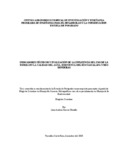| dc.contributor.author | García Obando, Lina A. | |
| dc.date.accessioned | 2014-10-20T05:41:53Z | |
| dc.date.available | 2014-10-20T05:41:53Z | |
| dc.date.issued | 2003 | es_ES |
| dc.identifier.uri | https://repositorio.catie.ac.cr/handle/11554/5578 | |
| dc.description | Tesis (Mag. Sc.) -- CATIE, 2003 | es_ES |
| dc.description.abstract | Entre los meses de marzo a julio del 2003 se efectuó una caracterización del estado físico químico, biológico y geomorfológico, los datos fueron colectados en doce estaciones ubicadas en la Subcuenca del Río Tascalapa, Yoro Honduras, agrupadas en dos tratamientos, cuatro estaciones con BOSQUE y nueve estaciones con CULTIVOS CASAS. Los nitratos, fosfatos, sólidos disueltos totales, coliformes fecales, turbiedad, pH y temperatura podrían ser los principales parámetros a tener en cuenta en las futuras evaluaciones. La interrelación que se observó entre el uso de la tierra, la calidad geomorfológica del canal, la presencia de determinados macroinvertebrados bentónicos y los índices bióticos, muestran que los macroinvertebrados son buenos predictores del estado de calidad del agua de las fuentes y pueden ser empleados como herramienta para medir los impactos de la adopción de tecnologías de conservación y restauración de cuencas. | es_ES |
| dc.description.abstract | The physical, chemical, biological and geomorphological conditions were characterized for 12 sampling stations located in the Tascalapa River subwatershed between March and July 2003. Sampling stations were grouped into two treatments: four stations were dominated by forest, and nine stations by agriculture and human settlements. The nitrate, phosphate, total dissolved solids, and fecal coliform content, together with turbidity, pH and temperature could be the principal parameters applied to future assessments. The interrelationship observed between land use, geomorphological quality of the channel, the presence of specific benthic macroinvertebrates, and biotic indices show that macroinvertebrates are good indicators of water quality at source, and therefore could serve as an effective tool to evaluate the impacts of implementing measures for the conservation and restoration of watersheds. Likewise, during future monitoring exercises, the BMWP index calculation could be complemented with the geomorphological index of the channel, a low cost monitoring option that could be easily implemented by local institutions. | |
| dc.format.extent | 144 páginas | |
| dc.format.extent | 164 páginas | |
| dc.language.iso | es | es_ES |
| dc.publisher | CATIE, Turrialba (Costa Rica) | es_ES |
| dc.relation.ispartof | Maestría en Manejo y Gestión en Cuencas Hidrográficas | |
| dc.rights | info:eu-repo/semantics/openAccess | |
| dc.subject | CUENCAS HIDROGRAFICAS | |
| dc.subject | AGUA | |
| dc.subject | CALIDAD DEL AGUA | |
| dc.subject | BIODECONTAMINACION | |
| dc.subject | POLUCION DEL AGUA | |
| dc.subject | ANALISIS DE AGUA | |
| dc.subject | DESECHOS AGRICOLAS | |
| dc.subject | COMUNIDADES ACUATICAS | |
| dc.subject | PROPIEDADES FISICOQUIMICAS | |
| dc.subject | UTILIZACION DE LA TIERRA | |
| dc.subject | HONDURAS | |
| dc.title | Indicadores técnicos y evaluación de la influencia del uso de la tierra en la calidad del agua, subcuenca del río Tascalapa Yoro, Honduras | es_ES |
| dc.title.alternative | Technical indicators and land use assessment regarding water quality in the Tascalapa River subwatershed, Yoro, Honduras | es_ES |
| dc.type | Tesis de maestría | es_ES |
| dcterms.rights | acceso abierto | es_ES |
| dc.identifier.publication | Turrialba (Costa Rica) | es_ES |


